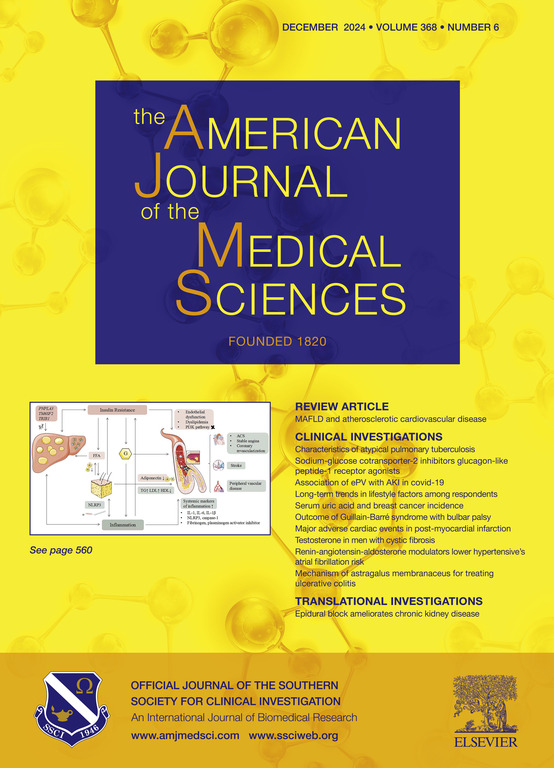Effect of mean heart rate on 30-day mortality in older patients with sepsis: Data from the MIMIC-IV database
IF 2.3
4区 医学
Q2 MEDICINE, GENERAL & INTERNAL
引用次数: 0
Abstract
Background
Sepsis is a critical condition with a significant risk of mortality. Advanced age is one factor in increasing mortality in intensive care.
Objectives
The aim of this study is to investigate the association between mean heart rate (MHR) and 30-day mortality among older patients with sepsis in the intensive care unit (ICU).
Methods
All older patients (age 65 or older) with sepsis for first time in ICU admission in Medical Information Mart for Intensive Care-IV (MIMIC-IV) were included in this retrospective study. The effect of MHR within 24 h of ICU admission on 30-day mortality was assessed according to multivariable Cox regression models, restricted cubic splines and two-piecewise Cox regression models.
Results
The total number of participants was 6598 (mean heart rate, 83.8 ± 14.3 bpm). A total of 1295 (19.6%) patients died within 30 days after ICU admission. MHR within 24 h of admission was associated with 30-day mortality (J-shaped association) in older patients with sepsis in the ICU, with an inflection point at about 74 bpm and a minimal risk observed at 73 to 82 bpm of MHR.
Conclusions
In this retrospective cohort study, there was a J-shaped association between MHR and 30-day mortality in older patients with sepsis admitted to the ICU and a minimal risk observed at 73 to 82 bpm of MHR. If further confirmed, this association may provide a theoretical basis for formulating the target strategy of heart rate therapy for these patients.
平均心率对老年败血症患者 30 天死亡率的影响:来自 MIMIC-IV 数据库的数据。
背景:败血症是一种危重病,死亡率很高。高龄是增加重症监护死亡率的一个因素:本研究旨在调查重症监护室(ICU)中患有败血症的老年患者的平均心率(MHR)与 30 天死亡率之间的关系:这项回顾性研究纳入了重症监护医学信息市场-IV(MIMIC-IV)中所有首次入住重症监护室的老年脓毒症患者(65 岁或以上)。根据多变量 Cox 回归模型、限制性立方样条和双片式 Cox 回归模型评估了入院 24 小时内 MHR 对 30 天死亡率的影响:结果:参与研究的总人数为 6598 人(平均心率为 83.8±14.3 bpm)。共有 1295 名(19.6%)患者在入住 ICU 后 30 天内死亡。入院24小时内的MHR与重症监护室老年脓毒症患者30天内的死亡率有关(J形关联),拐点在74 bpm左右,MHR在73至82 bpm时风险最小:在这项回顾性队列研究中,入住重症监护室的老年脓毒症患者的 MHR 与 30 天死亡率呈 "J "形关联,MHR 在 73 至 82 bpm 时风险最小。如果得到进一步证实,这种关联可为制定这些患者的心率治疗目标策略提供理论依据。
本文章由计算机程序翻译,如有差异,请以英文原文为准。
求助全文
约1分钟内获得全文
求助全文
来源期刊
CiteScore
4.40
自引率
0.00%
发文量
303
审稿时长
1.5 months
期刊介绍:
The American Journal of The Medical Sciences (AJMS), founded in 1820, is the 2nd oldest medical journal in the United States. The AJMS is the official journal of the Southern Society for Clinical Investigation (SSCI). The SSCI is dedicated to the advancement of medical research and the exchange of knowledge, information and ideas. Its members are committed to mentoring future generations of medical investigators and promoting careers in academic medicine. The AJMS publishes, on a monthly basis, peer-reviewed articles in the field of internal medicine and its subspecialties, which include:
Original clinical and basic science investigations
Review articles
Online Images in the Medical Sciences
Special Features Include:
Patient-Centered Focused Reviews
History of Medicine
The Science of Medical Education.

 求助内容:
求助内容: 应助结果提醒方式:
应助结果提醒方式:


